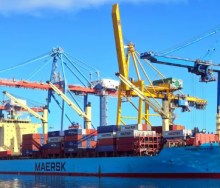Transnet is forging ahead with several property developments, including a new deepwater port and rail network to serve the country’s proposed new Boegoebaai hydrogen production hub and mines in the Northern Cape.
Transnet National Ports Authority (TNPA) on Thursday issued a Request for Qualification (RFQ) for the development of the new port and associated rail infrastructure planned for the Northern Cape. The parastatal also approached the market for the redevelopment of two prime properties in Johannesburg and Cape Town.
TNPA said it was calling on port and rail developers to respond to its RFQ for the design, funding and construction of the new port and rail infrastructure in the Northern Cape. TNPA said the RFQ was intended to obtain information to shape the final solution as well as to select qualifying developers who could “undertake the design, funding and construction of a capital-efficient greenfield deepwater port and associated infrastructure”. The RFQ also seeks a rail solution proposal to connect the port to the mining and industrial hubs in the province.
“The information sought through the RFQ is necessary for TNPA to chart a way forward in line with our strategic objective to operationalise a port in the region by 2026,” TNPA programme director, Magenthran Ruthenavelu, said.
The development of a port in the Northern Cape can be seen as the first step towards realising the country’s Green Hydrogen Strategy, which has been regarded as an important driver of a just energy transition. Sasol’s feasibility study to explore the potential of Boegoebaai as an export hub for green hydrogen and ammonia should be completed within the next 24 months. The “green hydrogen” development, located in the Namakwa Special Economic Zone, has been designated a Strategic Integrated Project (SIP) in the South African National Development Plan.
Ruthenavelu said the port would also provide connectivity for exports of other mining products.
“Over and above the catalytic effect of new port and rail infrastructure to the local economy, the investment could also provide an additional, cost-effective channel to market for manganese exporters in the province. It will bring much-needed relief to emerging miners who are currently restricted by high road transportation costs and no access to current export channels due to capacity constraints,” Ruthenavelu said.
Meanwhile, Transnet Property, an operating division of Transnet SOC Limited, has announced that it plans to redevelop its Carlton Centre and 1 Adderley Street properties as part of its corporate strategy to optimise portfolio returns and strengthen its balance sheet.
Transnet issued two Requests for Information (RFI) to the market to assess the availability of potential property developers, investors, funders, and financiers for the joint redevelopment of the properties.
The construction of the Carlton Centre precinct began in the early 1960s and was completed in 1973. At 223 metres high, the Carlton Office Tower is among the top three tallest buildings on the continent. The precinct consists of the office tower, retail section, Skyrink and hotel. Only the retail section is fully functional.
Carlton Towers consists of 68 000m² of office space, while The Carlton Shopping Centre comprises 53 000m² of retail space. The 66-room hotel is currently mothballed. The Carlton Court (Annex Building) has 63 rooms and is the smaller hotel annex across Kruis Street from the hotel, connected by a pedestrian bridge to the old hotel lobby.
The Adderley Street Precinct, a landmark building at the bottom of Adderley Street overlooking Heerengracht Street, is considered a key asset for Transnet in the Cape Town CBD. The building is currently partially occupied (43%) by a handful of tenants, including Transnet, Prasa Cape Town, Metrorail, and Rovos Rail Tours. The external parking area and Old Marine Drive are also being let and managed by a third party.













